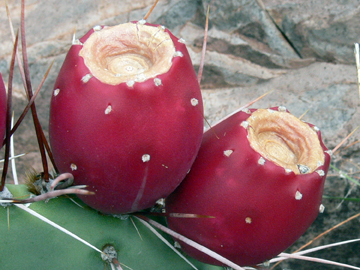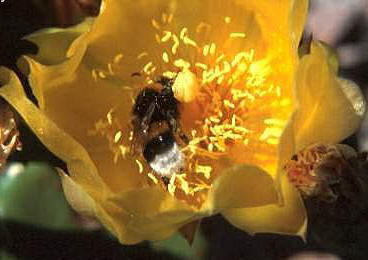Interactions
 The Eastern Prickly Pear has very few
harmful predators due to its sharp spikes. However, humans can
be a danger to this plant. Its fruit is often harvested for
human consumption. The fruit can be used to make c
The Eastern Prickly Pear has very few
harmful predators due to its sharp spikes. However, humans can
be a danger to this plant. Its fruit is often harvested for
human consumption. The fruit can be used to make c andies,
jellies, drinks, and many other things. It was also be eaten raw after
it has been properly cleaned to get all of the spikes off. The
pads of the cactus can also be cooked and eaten.
andies,
jellies, drinks, and many other things. It was also be eaten raw after
it has been properly cleaned to get all of the spikes off. The
pads of the cactus can also be cooked and eaten.
Other than consumption, the cactus has also shown some
positive results being used in medicine. Some compounds that it
contains with
medical relevance are 3-methoxytyramine,
candicine, hordenine, N-methyltyramine, and tyramine.
These compounds provide a wide variety of benefits to the body.
Some act as antibiotics and others play a role in hormone
production and distribution. Opuntia is also being
studies as a possible treatment for type II diabetes. Interested
in other organisms used in medicine? Click here to learn about
the antibiotic penicillin.
 Other than humans, insects also interact with this plant. The
bumblebee has a mutualistic relationship with the cactus in that
the bee feeds on the sweet sap of the plant and in doing so
spreads pollen from the flower. Some birds also tend to eat the
fruit of the plant. This consumption of the fruit helps spread
the seeds so more plants can grow. To learn more about how these
animals affect the life of the Prickly Pear, visit the
Reproduction portion of this
site.
Other than humans, insects also interact with this plant. The
bumblebee has a mutualistic relationship with the cactus in that
the bee feeds on the sweet sap of the plant and in doing so
spreads pollen from the flower. Some birds also tend to eat the
fruit of the plant. This consumption of the fruit helps spread
the seeds so more plants can grow. To learn more about how these
animals affect the life of the Prickly Pear, visit the
Reproduction portion of this
site.